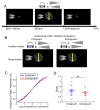Embodied Cross-Modal Interactions Based on an Altercentric Reference Frame
- PMID: 38671966
- PMCID: PMC11048532
- DOI: 10.3390/brainsci14040314
Embodied Cross-Modal Interactions Based on an Altercentric Reference Frame
Abstract
Accurate comprehension of others' thoughts and intentions is crucial for smooth social interactions, wherein understanding their perceptual experiences serves as a fundamental basis for this high-level social cognition. However, previous research has predominantly focused on the visual modality when investigating perceptual processing from others' perspectives, leaving the exploration of multisensory inputs during this process largely unexplored. By incorporating auditory stimuli into visual perspective-taking (VPT) tasks, we have designed a novel experimental paradigm in which the spatial correspondence between visual and auditory stimuli was limited to the altercentric rather than the egocentric reference frame. Overall, we found that when individuals engaged in explicit or implicit VPT to process visual stimuli from an avatar's viewpoint, the concomitantly presented auditory stimuli were also processed within this avatar-centered reference frame, revealing altercentric cross-modal interactions.
Keywords: altercentric reference frame; cross-modal interactions; embodied processing; visual perspective-taking.
Conflict of interest statement
The authors declare no conflicts of interest.
Figures



Similar articles
-
Does altercentric interference rely on mentalizing?: Results from two level-1 perspective-taking tasks.PLoS One. 2018 Mar 22;13(3):e0194101. doi: 10.1371/journal.pone.0194101. eCollection 2018. PLoS One. 2018. PMID: 29566019 Free PMC article.
-
Age of avatar modulates the altercentric bias in a visual perspective-taking task: ERP and behavioral evidence.Cogn Affect Behav Neurosci. 2018 Dec;18(6):1298-1319. doi: 10.3758/s13415-018-0641-1. Cogn Affect Behav Neurosci. 2018. PMID: 30242574 Free PMC article.
-
The effect of avatar identity on spontaneous perspective-taking in patients with schizophrenia.Schizophrenia (Heidelb). 2025 Jan 25;11(1):9. doi: 10.1038/s41537-024-00551-4. Schizophrenia (Heidelb). 2025. PMID: 39863649 Free PMC article.
-
Changing perspective: The role of vestibular signals.Neuropsychologia. 2015 Dec;79(Pt B):175-85. doi: 10.1016/j.neuropsychologia.2015.08.022. Epub 2015 Aug 24. Neuropsychologia. 2015. PMID: 26311354
-
Synesthetic Correspondence: An Overview.Adv Exp Med Biol. 2024;1437:101-119. doi: 10.1007/978-981-99-7611-9_7. Adv Exp Med Biol. 2024. PMID: 38270856 Review.
References
-
- Wang J., Zhang Z., Jia M. Understanding how leader humility enhances employee creativity: The roles of perspective taking and cognitive reappraisal. J. Appl. Behav. Sci. 2017;53:5–31. doi: 10.1177/0021886316678907. - DOI
Grants and funding
LinkOut - more resources
Full Text Sources

